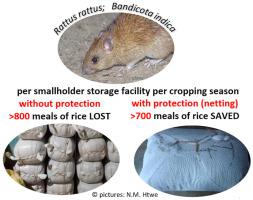Crop Protection ( IF 2.5 ) Pub Date : 2021-03-27 , DOI: 10.1016/j.cropro.2021.105638 Nyo Me Htwe , Siriwardana Rampalage Sarathchandra , Vincent Sluydts , Lionel Nugaliyadde , Grant R. Singleton , Jens Jacob

|
Several rodent species damage rice crops and commensal rodents cause damage to stored produce and infrastructure, hygienic problems and they can transmit zoonotic pathogens. In the first such study in Sri Lanka, we identified the main rodent and shrew species and the extent of post-harvest damage caused in rice storage facilities of smallholder farmers. Netting of rice bags was trialled as a new measure of protection. Field experiments were performed in the three main agro-ecological zones of Sri Lanka.
Five rodent species and one shrew species were captured in storage facilities. Rattus rattus, Bandicota indica and Suncus murinus were the dominant species in storage facilities. The small mammal composition was more related to season than to region. In storage, depending on region, 3.2–9.1% (mean 7.6%) of rice was lost to rodents when rice was stored indoors in unprotected polyethylene bags. Netting around bags reduced damage by 89% - equivalent to the annual rice consumption of one person per storage facility, reduced the presence of rodent droppings by 92% and the bag area damaged by rodents by 96%.
Our findings clearly show the considerable amount of damage caused by rodents to rice post-harvest across three agro-ecological zones of Sri Lanka and indicate that netting bags considerably reduces damage and contamination. This netting can be used to aid the development of an ecologically-based rodent management (EBRM) program tailored to local conditions. More detailed studies are needed to fully understand the population and breeding ecology of the relevant rodent pest species in relation to damage patterns to optimize management beyond individual structural measures.
中文翻译:

斯里兰卡的小型哺乳动物群落,与大米相关的损害和对小农大米储存设施的损害预防
几种啮齿动物对稻谷作物造成损害,而普通的啮齿动物对储存的农产品和基础设施造成损害,造成卫生问题,并且可以传播人畜共患病病原体。在斯里兰卡的第一项此类研究中,我们确定了小农户稻米贮藏设施中主要的啮齿动物和sh虫物种以及收获后损害的程度。尝试将米袋网作为一种新的保护措施。在斯里兰卡的三个主要农业生态区进行了田间试验。
在储存设施中捕获了5种啮齿动物和1种sh物种。褐家鼠,Band子(Bandicota indica)和cus子(Suncus murinus)是贮藏设施中的优势种。小型哺乳动物的组成与季节的关系比与区域的关系更大。在不同地区存储时,将大米存放在没有保护的聚乙烯袋中的室内,大米损失了3.2–9.1%(平均7.6%)的啮齿动物。袋子周围的网眼减少了89%的损坏-相当于每个存储设施每年消耗一人的大米,减少了92%的啮齿类动物粪便的存在,并且减少了96%的被啮齿动物损坏的袋子面积。
我们的发现清楚地表明,在斯里兰卡的三个农业生态区中,啮齿动物对水稻收割后的水稻造成了相当大的损害,并表明网袋大大减少了损害和污染。该网可用于协助开发适合当地条件的基于生态的啮齿动物管理(EBRM)计划。需要进行更详细的研究,以充分了解相关啮齿类害虫物种的种群和繁殖生态学与损害模式的关系,以优化除个别结构性措施之外的管理方式。











































 京公网安备 11010802027423号
京公网安备 11010802027423号